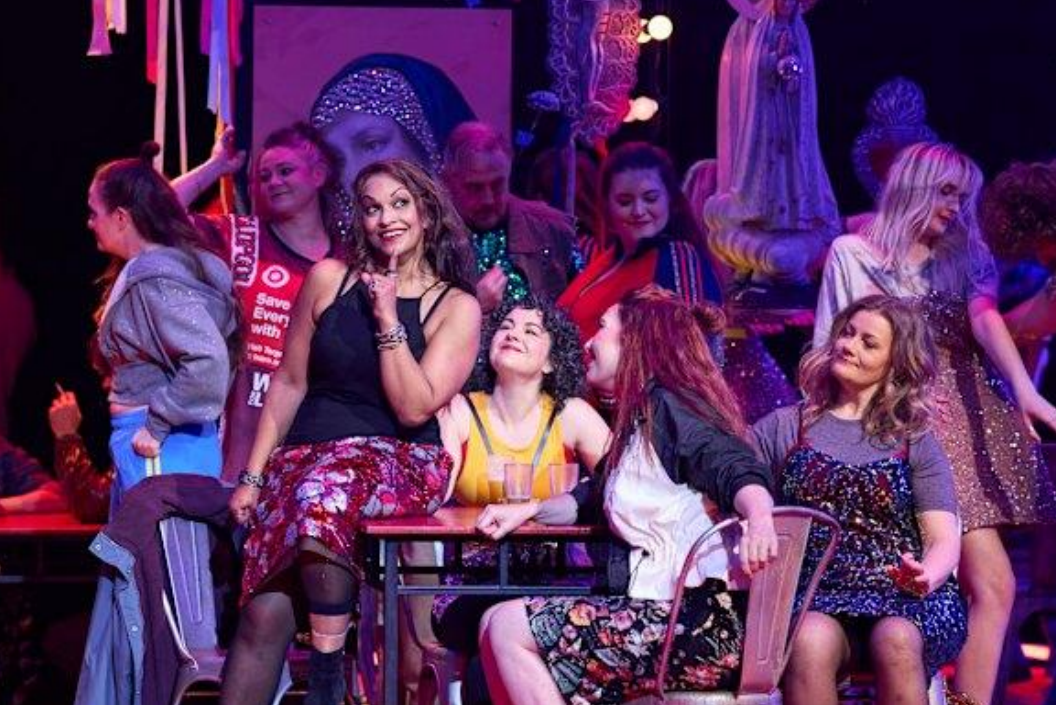
Carmen
Opera Australia
Sydney Opera House, July 10
Reviewed by Peter McCallum
★★★★
The opening scene is set in a park where a stone cross is protected by a security fence, itself defaced by hundreds of tourist padlocks. Director Anne-Louise Sarks has resisted the cliches of Spanishness and superficial sultry seduction that often plague productions of Carmen, replacing them with messy contemporary reality where beauty is an almost-hidden presence littered with trash, kitsch and ungainly design.

Danielle de Niese as Carmen (on table), Jane Ede as Frasquita and Helen Sherman as Mercedes. Credit: Keith Saunders
The obscured cross recurs in each of Marg Horwell’s four sets as a visual leitmotif for a forgotten truth. In the second act, gaudy religious art adorns the walls of Lillas Pastia’s dubious tavern, while the third is a lookout with car park lighting and a neon cross visible on glittering distant hills. The costumes are youthful, attention-grabbing and full of life, especially in the bullring of the final act where strange and wonderful characters in bright fancy dress leap to the fore, while the final tragedy unfolds in a claustrophobic dressing room.
Sarks’ finely detailed direction subtly shifts the story from a romantic crime-of-passion to an all-too-familiar tale of coercive control, while a truly stellar performance from Danielle de Niese as Carmen holds the stage with a glance, a gesture, and beautifully shaped melodic lines. De Niese moves insouciantly and impetuously, always with expressive litheness. Her upper register entwines the ear with silken mellifluousness, and the low register delivers darkly grained notes of implacable fatefulness. Abraham Breton started as a bashful Don Jose in Act 1, and small but growing gestures of menacing violence insinuated themselves as the action progressed. Vocally, he was strongest in his impassioned declaration La fleur que tu m’avais jetée in Act 2 and made the transition from pleading to violence in Act 4 with persuasive modulations of forcefulness. In Act 1 his pitch was unsettled and his duet with Jennifer Black as
Micaela didn’t gel. Black’s Micaela was characterised as plain homeliness rather than saintly purity, and her final dismissive gesture to Don Jose’s possessiveness was one of many moments that kept the drama plausible and engaging. But there was purity aplenty in Black’s pitch and her Act 3 aria was well-shaped and quietly telling.

The Opera Australia dancers provide colour and movement. Credit: Keith Saunders
Andrii Kymach’s Escamillo exuded the undaunted confidence of a person who stares down wild bulls for a living. His singing in the Toreador Song was well-moulded rather than stentorian. Jane Ede and Helen Sherman sang with lively colour as Frasquita and Mercedes, and Luke Gabbedy and Kanen Breen were lanky wiry smugglers, violent only when they needed to be. Andrew Moran’s Morales was as cheerful as Richard Anderson’s Zuniga was morose and Ruth Strutt as Lillas Pastia was ruthlessly efficient in calling time. In keeping with the production’s avoidance of the obvious, conductor Lidiya Yankovskaya never rushed the tempi or injected empty noise and energy, but rather allowed Bizet’s distinctive melodies to blossom with exactness and comeliness, harnessing the musical instincts of the Opera Australia orchestra. The Opera Australia Chorus began with laconic murmurs in Act 1, blazing out in splendid colour when moved to the front of the stage in later acts, while the Children’s Chorus sang with true tone and cheeky impertinence. Shannon Burns’ choreography had the informal knockabout daring one worries about in teenagers.

Leave a Reply